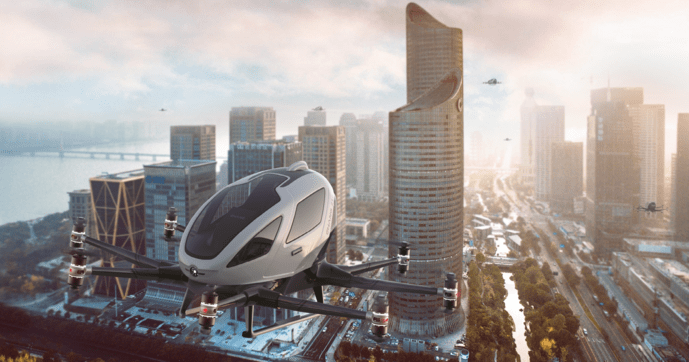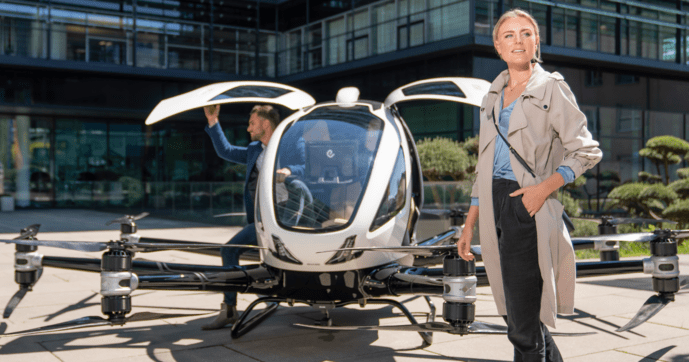Sharing economy and the mobility of tomorrow
19.08.2020
In order to get from A to B, many solutions have been established on the market in recent years that eliminate the need to own a car. A large proportion of these solutions relate to the Sharing Economy approach, which is based on the shared use of mobility solutions. These mobility services need to be highly frequented in order to become profitable and viable in the long term. Consequently, these developments can be observed above all in urban areas, as they are associated with a higher population density and thus a higher probability of use. Overall, sharing mobility solutions have an impact on the sustainable symbiosis of ecology and economy.
eVTOL Aircraft and Autonomous flying
The demand for mobility solutions with a positive ecological, social and economic impact will increase in complexity as the trend towards urbanisation continues to grow. In this context, the VTOL concept can be mentioned. This term stands for a locomotion with vertical take-off and landing. The addition of the letter "e" indicates an electric drive. These solutions are able to fly autonomously, i.e. without a pilot, because the on-board system takes over all tasks of a Pilot.

Challenges and risks
Particular mention should be made of the improvement of air traffic control systems, such as the Air Traffic Management System, and the associated certifications. Further challenges lie in the exclusion of system failures, for example through redundant system components, in order to be able to guarantee reliable operational safety. To enable autonomous air taxis to fly pre-programmed routes without danger, independent real-time route planning including screening of the environment for emergency situations is necessary. Above all, however, the challenge surrounding the e-propulsion system represents a high technical development effort. At this point, increasing capacities and improving the weight-to-power ratio is considered a challenge.
With regard to infrastructure planning and development, it is important to ensure take-off and landing facilities, which must be integrated into the cities in sufficient numbers to prevent bottlenecks. The way in which bookings are handled should also be mentioned here. Subsequently, integration into the existing transport system is necessary to achieve an intermodal transport chain, i.e. the combination of different modes of transport (road, rail, water and air). All these challenges are considered to be a premise for operating autonomous air taxis in a marketable way.
The possible mobility scenario of tomorrow with the EHang 216, a true eVTOL
Claudia and Stefan are on their way back from their vacation and are making the journey from the airport of a metropolis of millions to their shared apartment during rush hour.
The two have landed safely at the airport. Recently arrived, they decide on the short-haul offer of the company "Urban-Mobility-Alliance" in order to arrive at their place of residence as quickly as possible while minimizing travel time. Urban-Mobility-Alliance is a mobility provider that offers a highly service-oriented service for the way from A to B through its autonomous flight Taxis.

Claudia and Stefan opt for the EHang model, an air taxi that reaches a maximum cruising speed of 130 km/h. The non-stop range is currently 35 kilometres. With the non-stop range, the maximum range of current aircraft is reproduced without the aircraft having to make an intermediate landing.
To be able to use the flight service, the provider Urban-Mobility-Alliance offers an on-demand service. In addition to the on-demand service, the customer can choose between boarding and disembarking. Here Urban-Mobility-Alliance offers a station-based operation from the airport to a flight hub near the residence. In the future, the company also plans to offer a door-to-door service for an additional charge. However, this requires the creation of sufficient landing infrastructure.
The Urban Mobility Alliance's service can be booked directly via smartphone. The trip is billed automatically after the flight has been successfully completed.
While Claudia and Stefan have already arrived safely and relaxed at their destination, there are other factors influencing the business model of the Urban Mobility Alliance. These include the service scope, flight capacity, location focus and pricing.
The service scope of a provider differs depending on the planning performance of the focused service. The company Urban-Mobility-Alliance offers a full service scope. Mobility providers in the industry also make a decision on the capacity for passenger transport depending on the type of use (flight hailing or flight sharing). While the Urban Mobility Alliance's location focus is highly individual, other providers focus specifically on business people who want to get from A to B quickly, for example. The Urban Mobility Alliance charges per kilometre. Competitors with a similar customer focus have already switched to flat-rate pricing in order to provide customers with even greater convenience.
This is an example scenario of how users of urban mobility could take advantage of it in the future. Of course, many more such scenarios can be mapped from the model derived here.











